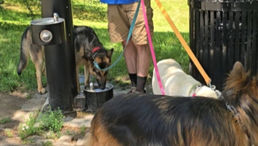Sit & Stay: How to Stop Your Dog From Pulling Leash the Easy Way
- Aleena Malik

- May 19
- 4 min read

Walking your dog should be one of the highlights of your day! Fresh air, a bit of exercise, and some quality time with your best furry friend. What’s not to love?
Well, if your dog thinks they’re gearing up for a sled dog race every time you clip on the leash, then you know exactly what’s not to love.
Leash pulling is one of the most common frustrations for dog owners, but the good news is, it's totally fixable with some simple strategies and a little patience!
Why Dogs Pull on Leash and How to Stop It
Understanding the "why" behind the behavior can make a world of difference. Here are the most common reasons dogs channel their inner sled dog:
They’re excited to explore: The great outdoors is full of smells, sights, and squirrels. Who wouldn’t be excited?
They’re overstimulated or under-exercised: A dog with pent-up energy or too much sensory input will often pull just to release that tension.
They’ve never been taught how to walk on a leash: It’s a learned skill, not something they're born knowing. Just like humans often assume everyone is a good communicator simply because we can talk, people assume dogs are naturally good on leash just because they can walk. But leash manners are a skill, and every dog learns differently.
Pulling has worked for them before: If pulling gets them to the park faster, why stop?
Quick Tip: Pulling isn’t your dog being stubborn or naughty. It’s just behavior that needs some reshaping. Think of it as teaching a kid not to shout in a library. New environment, new rules.
The “Sit & Stay” Reset Method
This method is simple, consistent, and incredibly effective. It's like hitting the pause button every time your dog goes into turbo mode.
When your dog pulls, stop walking immediately.
Ask for a "sit" and stay still.
Wait until they’re calm and making eye contact.
Start walking again.
Repeat. Every. Single. Time.

Why it works: You are breaking the cycle of "I pull, I get to move forward." It’s no fun at first. Expect some confused looks and dramatic dog sighs. But stick with it! Over time, they’ll learn that pulling gets them nowhere, while calm behavior keeps the walk going.
Bonus Tools & Tricks
Want to set yourself (and your pup) up for success? Here are some add-ons to make leash training easier:
Burn off some energy first: Play with your dog outside or have a short backyard fetch session before the walk. A quick energy release can make them more focused and less likely to pull.
Martingale collar (our top pick): These provide gentle correction without the added leverage dogs often get from harnesses. If your dog has a narrow head or tends to slip out of collars, a martingale can be a game-changer. Learn more in this overview of martingale collars by Preventive Vet.
Front-clip harness or gentle leader: While often helpful, these can sometimes give dogs more pulling power due to their full-body fit. Use with awareness, and choose what best suits your dog’s build and temperament. These tools give you better control and reduce pulling without hurting your dog. Learn more in this American Kennel Club guide to harnesses vs collars.
High-value treats: Think chicken, cheese, or your dog’s favorite snack. Make it worth their while.
Low-distraction environments: Start training in quiet areas before hitting the busy trails.
Verbal markers: A word like "easy" can help remind your dog to slow their roll. (Remember to stay consistent!)
Shorter, more frequent walks: Practice makes progress, and repetition helps the lesson stick.
When to Get Help
If your dog is especially strong, reactive, or just not responding to your efforts, don’t hesitate to call in a professional. Certified trainers can tailor a leash-walking plan that matches your dog’s unique energy, learning style, and quirks. You don’t have to go it alone.
Frequently Asked Questions
What’s the best way to stop my dog from pulling on the leash? Try the Sit & Stay Reset Method: stop walking the moment they pull, ask for a sit, and only continue when they’re calm.
Do martingale collars help with leash training? Yes. Martingale collars offer gentle correction and better control without the risk of a dog slipping out, especially for narrow-headed breeds.
Should I hire a trainer if leash pulling isn’t improving? Absolutely. A certified trainer can tailor methods and tools to your dog’s personality and energy level.
Final Woof
Leash manners don’t show up overnight, but with a bit of patience and a whole lot of consistency, they do show up. And when they do? Walks become way more fun for both of you. So grab your treats, leash up, and remember: every great dog walk starts with a little teamwork.
Need help giving your dog the exercise they need (without getting dragged down the block)? Book a dog walking session with Barkley’s Pets today. We’re here to make every walk a walk in the park!












Comments